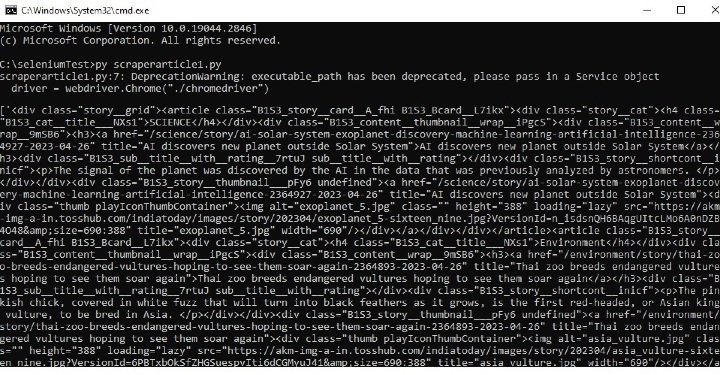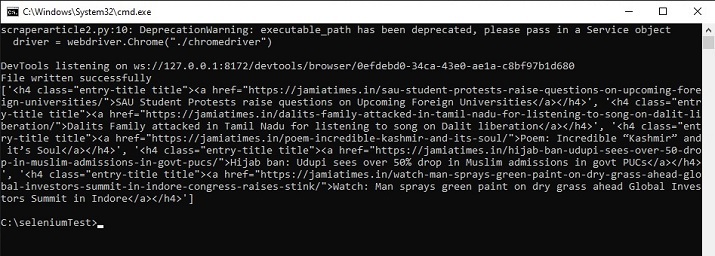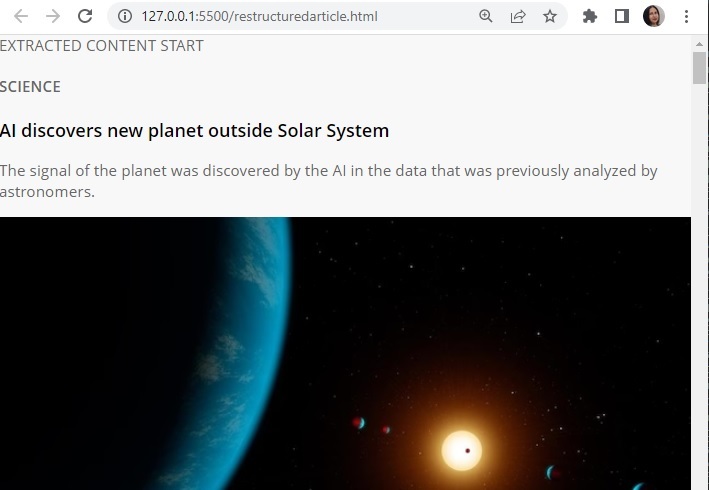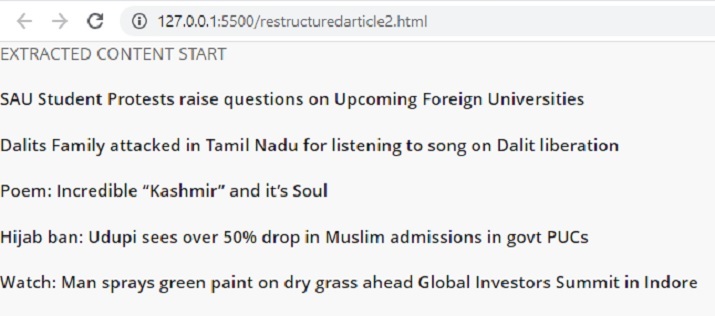如何使用Selenium Python定位元素?
随着网络内容技术的不断变化,经常需要重新设计和重构网页或网站的内容。 Selenium与Python是一个良好的组合,有助于从网页中提取所需的内容。 Selenium是一个免费的开源自动化工具,用于评估多平台的Web应用程序。 Selenium测试脚本可以用各种计算机语言编写,如Java、C#、Python、NodeJS、PHP、Perl等。本Python Selenium文章使用两个不同的示例,给出了使用Selenium定位网页元素的方法。 在这两个示例中,使用新闻网站提取内容。
定位要提取的元素-
打开要提取内容的网站。现在按右键并打开检查窗口。突出显示网页中的元素或部分,并从检查窗口查看其HTML设计规格。使用这些规格来定位元素。

示例1:使用Selenium与Python定位具有特定类名的div元素
算法
-
第1步 下载与Chrome相同版本的Chrome驱动程序。现在将该驱动程序保存在存储Python文件的相同文件夹中。
-
第2步 使用START_URL =“ https://www.indiatoday.in/science”.Import 用于解析的BeautifulSoup。使用“class”作为“story__grid”以定位div元素。
-
第3步 -指定网站URL,并启动驱动程序以获取URL。
-
第4步 -使用BeautifulSoup解析提取的页面。
-
第5步 -搜索所需类别的div标记。
-
第6步 -提取内容。通过将提取的内容包含在HTML标记内,将其打印并转换为html表单。
-
第7步 -编写输出HTML文件。运行程序。打开输出HTML文件并检查结果。
示例
from selenium import webdriver
from bs4 import BeautifulSoup
import time
START_URL =“https://www.indiatoday.in/science”
driver = webdriver.Chrome(“./chromedriver”)
driver.get(START_URL)
time.sleep(10)
def scrape():
temp_l = []
soup = BeautifulSoup(driver.page_source,“html.parser”)
for div_tag in soup.find_all(“div”,attrs = {“class”,“story__grid”}):
temp_l.append(str(div_tag))
print(temp_l)
enclosing_start =“<html><head><link rel = 'stylesheet'”+“href ='styles.css'></head><body>”
enclosing_end =“</body></ html>”
with open('restructuredarticle.html','w+',encoding ='utf-16')as f:
f.write(enclosing_start)
f.write('\n'+'<p> EXTRACTED CONTENT START </p>'+'\ n')
for items in temp_l:
f.write('%s'% items)
f.write('\ n' + enclosing_end)
print("文件已成功写入")
f.close()
scrape()输出
在命令窗口中运行Python文件-
打开cmd窗口。首先,我们将在cmd窗口中检查输出。然后打开保存的html文件以查看提取的内容。


示例2:使用Selenium与Python定位具有特定类名的h4元素
-
步骤1 – 首先根据Chrome版本下载chromedriver。 现在将该驱动程序保存在存储Python文件的同一文件夹中。
-
步骤2 – 使用START_URL =“https://jamiatimes.in/”来import BeautifulSoup解释器进行解析。使用“class”为“entry-title title”来定位h4元素。
-
步骤3 – 指定网站URL并启动驱动程序以获取URL。
-
步骤4 – 使用BeautifulSoup解析获取到的页面。
-
步骤5 – 查找所需类的h4标签。
-
步骤6 – 提取内容,打印并通过将提取的内容包含在HTML标记中将其转换为html格式。
-
步骤7 – 编写输出HTML文件。 运行程序。 打开输出HTML文件并检查结果。
示例
from selenium import webdriver
from bs4 import BeautifulSoup
import time
START_URL= "https://jamiatimes.in/"
driver = webdriver.Chrome("./chromedriver")
driver.get(START_URL)
time.sleep(10)
def scrape():
temp_l=[]
soup = BeautifulSoup(driver.page_source, "html.parser")
for h4_tag in soup.find_all("h4", attrs={"class", "entry-title title"}):
temp_l.append(str(h4_tag))
enclosing_start= "<html><head><link rel='stylesheet' " + "href='styles.css'></head> <body>"
enclosing_end= "</body></html>"
with open('restructuredarticle2.html', 'w+', encoding='utf-16') as f:
f.write(enclosing_start)
f.write('\n' + '<p> EXTRACTED CONTENT START </p>'+'\n')
for items in temp_l:
f.write('%s' %items)
f.write('\n' + enclosing_end)
print("文件成功写入")
f.close()
print(temp_l)
scrape() 输出结果
在命令窗口中运行Python文件-
打开cmd窗口。 首先我们将在cmd窗口中检查输出。 然后打开保存的html文件以查看提取的内容。


在这个Python Selenium文章中,介绍了两个不同的示例,展示了如何定位用于网站抓取的元素。 在第一个示例中,使用Selenium定位div标记,然后从新闻网站中抓取指定元素。 在第二个示例中,定位h4标记,然后从另一个新闻网站中提取所需的标题。
 极客教程
极客教程